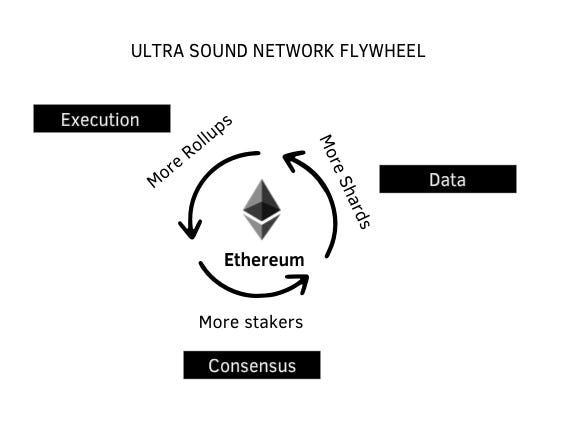The Triple Point Blockchain


Get Dharma, connect a bank, and get trading in less than 10 minutes. No gas fees on Polygon!
Dear Bankless Nation,
Last week we released a piece on Ultra Scalable Ethereum.
We believe the best path towards a globally-scaled blockchain builds on the modular design Ethereum is building towards.
With modular Ethereum, there is a positive feedback loop between the three modules that make up a blockchain.
Growth in one amplifies the power of the other. The more Ethereum scales, the more ETH captures value. The more valuable ETH becomes, the more Ethereum can scale.
Ethereum the Ultra Sound Money…
It’s time for you to meet Ethereum the Ultra Scalable Network.
![Handshake Emoji [Download iPhone Emojis] | Emoji Island Handshake Emoji [Download iPhone Emojis] | Emoji Island](https://bankless.ghost.io/content/images/public/images/5e766226-45bd-43e9-9163-62709d376e9f_600x411.png)
The Dual Flywheels ♾
ETH and Ethereum each have their own flywheels.
ETH has the triple point asset flywheel, where the value of ETH in one of its three categories amplifies its value in the others.
Ethereum has the triple point blockchain flywheel, where optimizations in one of its three modules amplify the optimizations in the others.
Let’s unpack this.
The Triple Point Asset
Ether is a triple-point asset. It’s the only asset that fits in all three asset superclasses at once, imbuing it with properties never before seen in financial markets.

1. Store of Value
ETH is used as collateral inside of DeFi applications.
Due to its inherent nativity to Ethereum, ETH operates as a pristine collateral asset inside of DeFi. The settlement assurances that ETH provides as collateral gives it favorable economic treatment as a collateral asset. We can see this as virtually every DeFi protocol supports ETH as a collateral type.
Better yet, it typically has higher margin allowances, lower liquidation penalties, and greater collateral composability.
ETH as an asset naturally stretches further and has preferential treatment over other assets inside the Ethereum economy.
2. Capital Asset
Ethereum secures itself by Proof of Stake where ETH is that ‘stake’. Validators stake their ETH on their promise to correctly validate the blockchain and, in return, are paid in ETH for their services.
This turns ETH into a capital-generating asset; even if you don’t want to run the validating computer yourself, you can still lend it out to someone or something that can do it for you, earning you the yield all the same. (Model of staking returns here.)
3. Commodity
Ethereum blockspace is a commodity that powers all parts of the Ethereum economy. It is the energy that powers the smart contracts and operates the network.
Using ETH, you pay for the computational resources that are required of the Ethereum network to process your transaction. It is the commodity money that exists inside of the Ethereum economy.
The Triple Point of ETH
Each of these properties of Ethereum feedback into each other. The ‘risk-free rate’ that ETH-staking provides ETH compounds its value as a collateral asset inside of DeFi. The demand for ETH as gas puts a constant bid on the market.
And meanwhile, the growth in ETH value adds to the financial incentive to run a validator for Ethereum, as these validators are paid in ETH.
The value of ETH is directly tied to the power of Ethereum, which brings us to…
The Triple Point Blockchain
Ethereum is a triple point blockchain. It’s the only blockchain to optimize for all three points of the blockchain trilemma, imbuing it with properties never before seen in the blockchain landscape.

1. Execution
Rollups are centralized blockchain networks (very few nodes) that have a cryptographic link to Ethereum. This link prevents the network from harming its users while maintaining the immutable properties of the Ethereum L1.
To achieve scale, rollups bundle up large amounts of economic activity and compress it into a single transaction that is sent to the Ethereum L1.
By removing the bottlenecks of a decentralized L1 blockchain, the full spectrum of viable economic activity is able to be expressed upon Ethereum.
Rollups are branches off of the main trunk of Ethereum, and will produce the surface area for Ethereum to capture new economic use cases for trustless blockchains.
2. Consensus
Proof of stake reduces the costs of providing security down to the absolute minimum: an internet-connected consumer computer and some capital. By removing the intensive hardware requirements of validating the blockchain like in Proof of Work, Ethereum includes the maximum number of potential computers that are capable of validating the blockchain.
The only missing piece is the necessary capital that is required to bond to Ethereum on the promise to correctly validate blocks. Therefore, Ethereum becomes both very secure, because capital is what secures the chain, and is also highly decentralized, in that computers and capital are generally found all over the world.
3. Data
Adding shards to a blockchain allows you to ‘spread out’ security across a horizontal scaling strategy. Rather than having 300,000 instances of Ethereum validators all validating one big blockchain, sharding allows Ethereum to more efficiently redistribute security across a wider landscape of shards. 300,000 validators validating one large chain turns into ~4,700 validators validating 64 smaller chains, that collectively are roughly 18x larger than the single chain.
The Triple Point of Ethereum
The beauty of the modular design is that the optimizations of each module amplify the optimizations in the others.
There are three synergies:
Modular PoS security can redistribute validators across more shards, as more validators come online and can securely support additional shards. More decentralization ➡️ more scale.
Additional shards on the L1 have amplified effects upon the execution capacity of rollups. Rollups can compress a lot of data before it adds it to an L1 shard, so any additional space that shards have has outsized impacts on the space available on rollups. More scale ➡️ faster execution.
The more net transaction activity that happens on the rollups, the more total fees are paid for buying L1 blockspace. The more fees paid for blockspace increases the revenue paid to L1 validators. The more validators are compensated, the larger the incentive there is to spin up additional validators.
Adding more validators to the L1 adds computational resources to Ethereum that contribute to making more shards.
More shards? See step 2.
Ultra Sound ETH 🤝 Ultra Scalable Ethereum
Both ETH and Ethereum have their own flywheels.

ETH
Each function that ETH has inside of Ethereum compounds its value as an asset. Each property of ETH induces its own inherent buying pressure on the market, which has additional outsized effects upon ETH as a Schelling point for money in the newly-established internet-native economy.
Ethereum
Ethereum has modularized all three components of a blockchain, and in doing so has created synergies where there used to be constraints.
- More validators staking ETH ➡️ More security for more shards
- More data available from more shards ➡️ much more data available on rollups
- More data available for rollups ➡️ Faster, cheaper rollup transactions
- Faster, cheaper transactions ➡️ More total net economic activity on Ethereum
- More total economic activity ➡️ More total fees paid by rollups to the L1 validators
- More fees paid to validators ➡️ Larger incentive to stake more ETH
- Repeat 🔄
ETH 🤝 Ethereum
There is an intrinsic relationship between the scalability of Ethereum and the soundness of ETH. The link between Ethereum scalability and the value of ETH occurs in step 6 when a validator receives ETH for validating the blockchain.
The value of ETH on the secondary markets impacts the value that is paid to validators for securing the network.
If ETH goes up in price, validators revenue grows.
Increased validator revenue increases Ethereum scalability.
All crypto-economic systems produce an intrinsic relationship between their currency and the blockchain it runs on. Ethereum takes this relationship to the next level by optimizing the link between the two.
Growth in Ethereum directly results in the increased value of ETH. Growth in the value of ETH directly produces a more scalable and secure Ethereum.
Flywheels are powerful. The magnitude of the power that these positive feedback loops create is hard for the human brain to comprehend. Humans can understand linear growth pretty easily, but feedback loops are an inherently exponential phenomenon. Positive feedback loops are found everywhere in emerging technologies (Metcalfe's Law basically models positive feedback loops) and are why 10-1,000x gains are normalized in crypto.
At the beginning stages of these paradigm-breaking technologies, the differences in market valuation between before the flywheels take effect and after are staggering.
And Ethereum has two of them.

Ethereum has produced a lot of ‘firsts’ for the world. It’s produced the first asset which transcends all three asset superclasses, and now it’s in the process of producing the first modular blockchain that scales as a function of its adoption.
Each one of these things is a breakthrough in its own respect.
What happens when these two breakthroughs ‘team up’ and help one another out?

Only time can tell, and it’s going to be glorious to watch unfold.
ETH 🤝 Ethereum
Ultra Sound Money 🤝 Ultra Scalable Network
∞
- David
Action Steps
- Execute any good market opportunities you saw
- Listen to Five Mental Models for Web3 | Chris Dixon